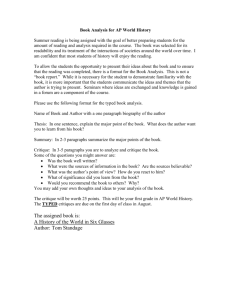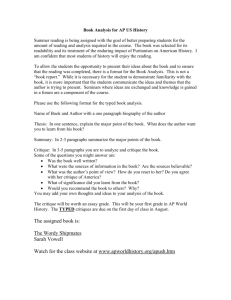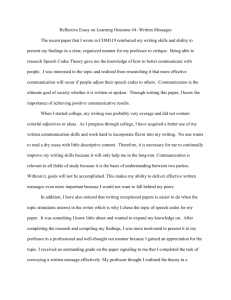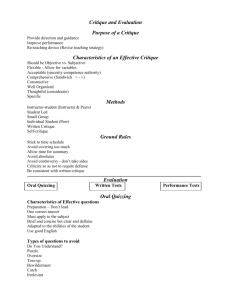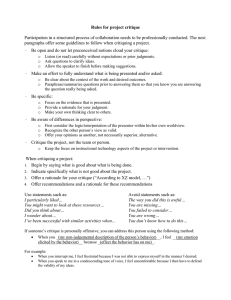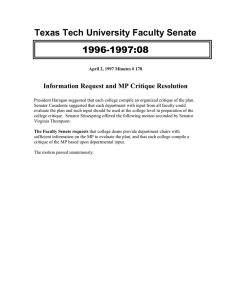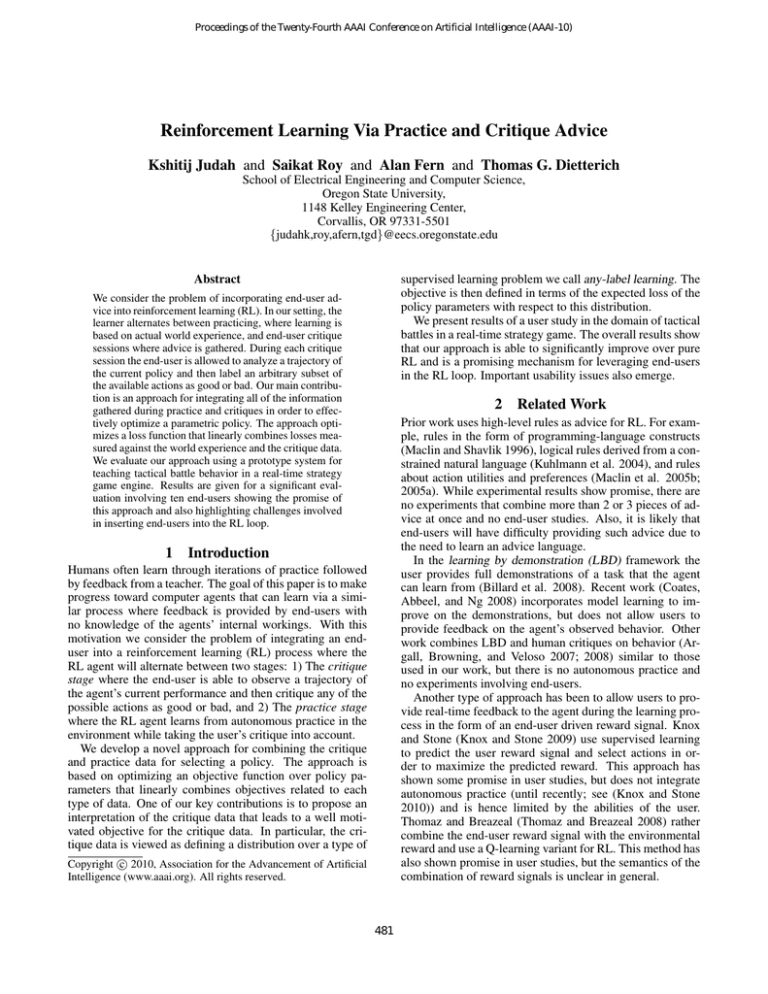
Proceedings of the Twenty-Fourth AAAI Conference on Artificial Intelligence (AAAI-10)
Reinforcement Learning Via Practice and Critique Advice
Kshitij Judah and Saikat Roy and Alan Fern and Thomas G. Dietterich
School of Electrical Engineering and Computer Science,
Oregon State University,
1148 Kelley Engineering Center,
Corvallis, OR 97331-5501
{judahk,roy,afern,tgd}@eecs.oregonstate.edu
Abstract
supervised learning problem we call any-label learning. The
objective is then defined in terms of the expected loss of the
policy parameters with respect to this distribution.
We present results of a user study in the domain of tactical
battles in a real-time strategy game. The overall results show
that our approach is able to significantly improve over pure
RL and is a promising mechanism for leveraging end-users
in the RL loop. Important usability issues also emerge.
We consider the problem of incorporating end-user advice into reinforcement learning (RL). In our setting, the
learner alternates between practicing, where learning is
based on actual world experience, and end-user critique
sessions where advice is gathered. During each critique
session the end-user is allowed to analyze a trajectory of
the current policy and then label an arbitrary subset of
the available actions as good or bad. Our main contribution is an approach for integrating all of the information
gathered during practice and critiques in order to effectively optimize a parametric policy. The approach optimizes a loss function that linearly combines losses measured against the world experience and the critique data.
We evaluate our approach using a prototype system for
teaching tactical battle behavior in a real-time strategy
game engine. Results are given for a significant evaluation involving ten end-users showing the promise of
this approach and also highlighting challenges involved
in inserting end-users into the RL loop.
1
2
Related Work
Prior work uses high-level rules as advice for RL. For example, rules in the form of programming-language constructs
(Maclin and Shavlik 1996), logical rules derived from a constrained natural language (Kuhlmann et al. 2004), and rules
about action utilities and preferences (Maclin et al. 2005b;
2005a). While experimental results show promise, there are
no experiments that combine more than 2 or 3 pieces of advice at once and no end-user studies. Also, it is likely that
end-users will have difficulty providing such advice due to
the need to learn an advice language.
In the learning by demonstration (LBD) framework the
user provides full demonstrations of a task that the agent
can learn from (Billard et al. 2008). Recent work (Coates,
Abbeel, and Ng 2008) incorporates model learning to improve on the demonstrations, but does not allow users to
provide feedback on the agent’s observed behavior. Other
work combines LBD and human critiques on behavior (Argall, Browning, and Veloso 2007; 2008) similar to those
used in our work, but there is no autonomous practice and
no experiments involving end-users.
Another type of approach has been to allow users to provide real-time feedback to the agent during the learning process in the form of an end-user driven reward signal. Knox
and Stone (Knox and Stone 2009) use supervised learning
to predict the user reward signal and select actions in order to maximize the predicted reward. This approach has
shown some promise in user studies, but does not integrate
autonomous practice (until recently; see (Knox and Stone
2010)) and is hence limited by the abilities of the user.
Thomaz and Breazeal (Thomaz and Breazeal 2008) rather
combine the end-user reward signal with the environmental
reward and use a Q-learning variant for RL. This method has
also shown promise in user studies, but the semantics of the
combination of reward signals is unclear in general.
Introduction
Humans often learn through iterations of practice followed
by feedback from a teacher. The goal of this paper is to make
progress toward computer agents that can learn via a similar process where feedback is provided by end-users with
no knowledge of the agents’ internal workings. With this
motivation we consider the problem of integrating an enduser into a reinforcement learning (RL) process where the
RL agent will alternate between two stages: 1) The critique
stage where the end-user is able to observe a trajectory of
the agent’s current performance and then critique any of the
possible actions as good or bad, and 2) The practice stage
where the RL agent learns from autonomous practice in the
environment while taking the user’s critique into account.
We develop a novel approach for combining the critique
and practice data for selecting a policy. The approach is
based on optimizing an objective function over policy parameters that linearly combines objectives related to each
type of data. One of our key contributions is to propose an
interpretation of the critique data that leads to a well motivated objective for the critique data. In particular, the critique data is viewed as defining a distribution over a type of
c 2010, Association for the Advancement of Artificial
Copyright Intelligence (www.aaai.org). All rights reserved.
481
3
Overall Approach
Algorithm 1 Main loop of our approach.
1: loop
2:
// Begin critique stage.
3:
C := C ∪ G ET C RITIQUE DATA(θ)
Problem Formulation. We consider reinforcement learning (RL) in the framework of Markov decision processes
(MDPs), where the goal is to maximize the expected total
reward from an initial state. It is assumed that all policies
are guaranteed to reach a terminal state in a finite number
of steps. Extending to discounted infinite horizon settings
is straightforward. In this work, we incorporate an end-user
into the usual RL loop. The user-agent interaction alternates
between two stages: 1) Get critique data C from the user
regarding the current policy, and 2) Update policy via autonomous practice while factoring in the critique data.
In stage 1, we focus on a simple form of critique data
that is reasonable for end-users to provide. The end-user is
allowed to observe the execution of the agent’s current policy and then scroll back and forth along the trajectory and
mark any of the available actions in any state as good or
bad. The
stagesis a critique data set:
result of−the critiquing
+
−
C = (s1 , c+
1 , c1 ), ..., (sM , cM , cM ) , where si is a state
−
and c+
i and ci are sets of actions that are labeled as good and
bad for si . No constraints are placed on which states/actions
are included in C, and it is expected that for many states
−
on the trajectories one or both of c+
i and ci will be empty.
+
Intuitively, the actions in ci are those that the end-user believes are “equally optimal” while those in c−
i are those that
are considered to be sub-optimal. In many domains, it is
possible for there to be multiple optimal/satisfactory actions,
which is why we consider sets of actions. One contribution
of this paper (Section 4) is to propose a semantics for C that
supports a principled approach to policy optimization.
In stage 2 of our protocol, the agent practices by interacting with the MDP as in traditional RL, but while taking the current critique data into account. This generates a set of trajectories T = o{T1 , ..., TN }, where Ti =
n
Li Li
t
t
t
i
(s1i , a1i , ri1 ), ..., (sL
i , ai , ri ) and si , ai , and ri are the
state, action and reward at time t in Ti . Thus, during the
practice session and before the next critique session, the
agent has two sets of data T and C available. The fundamental problem is thus to use T and C in order to select an
agent policy that maximizes reward in the environment.
Solution Approach. We consider learning the parameters
θ of a stochastic policy πθ (a|s), which gives the probability
of selecting action a in state s given θ. We use a standard
log-linear policy representation πθ (a|s) ∝ exp(f (s, a) · θ),
where f (s, a) is a feature vector of state-action pairs and θ
weighs features relative to one another. Our problem is now
to use the data sets T and C in order to select a value of θ
that maximizes the expected total reward of πθ .
Our high-level approach is to optimize θ with respect to a
combined objective function:
Jλ (θ, C, T ) = λU (θ, T ) − (1 − λ)L(θ, C)
4:
// Begin practice stage.
5:
T := T ∪ G ET P RACTICE T RAJECTORIES(θ)
6:
for i = 1:n do
7:
λ = λi //choose a value of λ
8:
θi = argmaxθ Jλ (θ, C, T ) // see Equation 1
9:
Ui = E STIMATE U TILITY(θi ) // by executing πθi
10:
end for
11:
i∗ = argmaxi Ui
12:
θ = θi∗
13: end loop
will use differentiable functions for U and L, and thus, for
a fixed λ, Jλ can be optimized via gradient descent. Supervised actor-critic learning (Rosenstein and Barto 2004)
follows a similar approach where online policy updates are
driven by a combined reward and supervisory signal. In that
work, a schedule for adjusting the value of λ was proposed.
However, we have found that in practice, fixing a schedule
for λ is difficult since the best choice varies widely across
users, domains, and data quality. Thus, instead we use an
explicit validation approach, where part of the practice session is used to evaluate different values of λ.
Algorithm 1 gives the main loop of our approach, which
starts by collecting critique data using the current policy
(line 3). Next the practice session begins, and additional
trajectories (line 5) are collected via exploitation of the current policy and exploration1 . Next (lines 6-10) the algorithm
considers different values of λ, for each one optimizing Jλ
and then estimating the expected utility of the resulting policy by averaging the results of a number of policy executions. In our experiments, we used 11 values of λ equally
distributed in [0, 1]. Finally, θ is set to the parameter value
that yielded the best utility estimate. The ability to easily
optimize for different values of λ is one of the advantages of
our batch-style learning approach. It is unclear how a more
traditional online approach would support such validation.
Trajectory Data Objective. To compute U (θ, T ) it is
straightforward to use likelihood weighting in order to estimate the utility of πθ using off-policy trajectories T , an approach that has been previously considered for policy gradient RL (Peshkin and Shelton 2002). Let pθ (Tj ) be the probability of πθ generating trajectory Tj and let θj be the parameters of the policy that generated Tj .X
An unbiased utility esti1
mate is given by: U (θ, T ) = W (T )
w(Tj )Rj , w(Tj ) =
Tj ∈T
pθ (Tj )
pθj (Tj )
P
where W (T ) = Tj ∈T w(Tj ) and Rj denotes cumulative reward of trajectory Tj . Note that the unknown
MDP dynamics cancel out of the weighting factor w(Tj ),
(1)
where λ ∈ [0, 1]. U (θ, T ) is an estimate of the expected
utility of πθ based on T (details below) and L(θ, C) is a
loss function that measures the disagreement between θ and
C (details in Section 4). λ specifies the relative influence
of T versus C, where λ = 1 corresponds to pure RL, and
λ = 0 corresponds to pure supervised learning from C. We
1
In our experiments, each practice stage generated 10 trajectories in the following way: with 0.8 probability the trajectory was
generated by the current policy; otherwise, the parameter vector
was divided by a randomly drawn constant to increase the temperature of the policy to facilitate exploration.
482
situation where either c+ or c− is empty.
The key idea behind our loss function is to define a user
model that induces a distribution over ALL problems given
the critique data. The loss is then related to the expected
ALL likelihood with respect to this distribution. We define
a user model to be a distribution Q(O(s)|c+ , c− ) over sets
O(s) ∈ 2A (where A is the action set) conditioned on the
critique data for s and assume independence among different states. We analyze a simple model involving two noise
parameters + and − and a bias parameter δ. The parameters + (− ) represents the rate of noise for good (bad) labels
and δ is the bias probability that an unlabeled action is in
O(s). The user model Q further assumes that the actions in
O(s) are conditionally independent given the critique data,
giving the following:
leaving only factors related to the policies. The gradient of
U (θ, T ) has a compact closed form.
4
Critique Data Objective
We now give our formulation for L(θ, C). We first introduce a supervised learning problem we call any-label learning (ALL) and then extend it to incorporate critique data.
Any-Label Learning. We consider a view of the enduser, where for any state s, there is a set of actions O(s)
that the user considers to be “equally optimal” in the sense
that actions in O(s) are considered to be equally good, but
strictly better than actions outside of O(s). The set of actions will vary across users and even for the same user across
time. Also, in many cases, these sets will not correspond to
the true set of optimal actions in the MDP. However, if the
end-user is reasonably competent in the application domain,
it is reasonable to assume that, if available, learning from
O(s) would likely provide useful guidance.
Given an ideal end-user, we could elicit the full action sets
O(s) for states along the observed trajectories, resulting in a
supervised training set of states labeled by action sets:
{(s1 , O(s1 )), ...., (sM , O(sM ))}. A natural learning goal
for this data is to find a probabilistic policy, or classifier,
that has a high probability of returning an action in O(si )
when applied to si . That is, it is not important which particular action is selected as long as the probability of selecting an action in O(s) is high. This leads to the definition of the ALL supervised learning problem where the
input is a set of data of the above form assumed to be
drawn i.i.d. and the goal is to learn policy parameters that
QM
maximize the ALL
i=1 πθ (O(si )|si ) where
P likelihood:
πθ (O(si )|si ) = a∈O(si ) πθ (a|si ).
ALL is distinct from other supervised learning problems where instances/states are associated with sets of labels/actions. The multi-label learning problem (Tsoumakas
and Katakis 2007) differs in that the goal is to learn a classifier that outputs all of the labels in sets and no others. This
objective is not appropriate for our problem, where we only
care about outputting one of the labels and do not care about
the relative probabilities assigned to the actions in O(si ).
The multiple-label learning problem (Jin and Ghahramani
2003) interprets the label sets as possible labels only one of
which is the true label. Thus, in multiple-label learning, the
label sets are used to encode label ambiguity, which is in
sharp contrast to ALL.
Expected Any-Label Learning. It is unlikely that endusers will actually provide the full action sets O(s). For
example, they will often indicate that the action selected by
the agent is bad and possibly mark one other action as good,
even when there are multiple good alternatives. Thus, in reality we must make due with only the good and bad action
sets c+ and c− for a state, which only provide partial evidence about O(s). The naive approach of treating c+ as the
true set O(s) can lead to difficulty. For example, when there
are actions outside of c+ that are equally good compared to
those in c+ , attempting to learn a policy that strictly prefers
the actions in c+ results in difficult learning problems. Furthermore, we need a principled approach that can handle the
Q(O(s)|c+ , c− ) =
q(a ∈ O(s)|c+ , c− )
q(a ∈
/ O(s)|c+ , c− )
(2)
a∈O(s)
/
a∈O(s)
+
−
q(a ∈ O(s)|c , c ) =
1 − + ,
− ,
δ,
if a ∈ c+
if a ∈ c−
if a 6∈ c+ ∪ c−
While simple, this model can capture useful expectations
about both a domain (e.g. typical number of good actions)
and the users (e.g. mislabeling rate).
Given Q, the distribution over ALL training sets D =
{(s1 , O(s1
)), . . . , (sM , O(sM ))} conditioned
on critique
−
+
−
data C = (s1 , c+
1 , c1 ), ..., (sM , cM , cM ) is: P (D|C) =
QM
+ −
i=1 Q(O(si )|ci , ci ). Our loss function L(θ, C) is now
defined as the negative log of the expected ALL likelihood,
M
X
−
log(E πθ (O(si )|si )|c+
(3)
L(θ, C) = −
i , ci )
i=1
where O(si ) is a random variable distributed as
−
Q(O(si )|c+
Computing L(θ, C) by expanding
i , ci ).
each expectation is impractical, since there are |2A | terms
in each. However, the loss function has a compact closed
form for the above user model.
Theorem 1. If the user model is given by Equation 2 then
M
−
−
log δ + (1 − + − δ)πθ (c+
i ) + ( − δ)πθ (ci )
L(θ, C) = −
i=1
.
Proof. (Sketch) The expected ALL likelihood inside each
logarithm term of L(θ, C) is given by
−
Q(O|c+
i , ci )πθ (O|si )
−
E πθ (O(si )|si )|c+
=
i , ci
O∈2A
−
Q(O|c+
i , ci )
=
=
πθ (a|si )
a∈O
O∈2A
−
Q(O|c+
i , ci )
πθ (a|si )
a∈A
O∈2A :a∈O
−
−
= δ + (1 − + − δ)πθ (c+
i ) + ( − δ)πθ (ci )
The final equality follows from the following relation.
−
+ −
Q(O|c+
i , ci ) = q(a ∈ O(si )|ci , ci )
O∈2A :a∈O
483
In our experiments, we assume a noise free (+ =
− = 0) and unbiased (δ = 0.5) user model which yields:
PM
−
L(θ, C) = i=1 log(1 + πθ (c+
i ) − πθ (ci )) + k where k is
a constant. Optimizing this loss function results in maximizing the probability on c+
i while minimizing the probability
on c−
,
which
agrees
with
intuition for this model. The grai
dient of this objective is straightforward to calculate for our
log-linear policy representation.
5
CS backgrounds and 4 without a CS background. For each
user, the study consisted of teaching both the pure supervised and the combined systems, each on a different map,
for a fixed amount of time. We attempted to maintain a balance between which map and learning system was used first
by each user. We allowed 30 minutes for the fully supervised system and 60 minutes for the combined system, due
to the additional time required by the combined system for
the practice periods. This time difference is intended to give
the users the chance of providing roughly the same amount
of advice in both cases. Note that in a real training scenario,
an end-user would not be confined to the system during the
practice stages, as they are in the user study, meaning that the
practice sessions will typically have lower cost to the user in
reality than in the user study. It also means that we necessarily had to use shorter practice stages than might typically
be used in a real application. In our studies, practice session
times ranged from 3 to 7 minutes depending on the amount
of data and convergence rate of gradient descent.
Experimental Setup
RTS Tactical Micro-Management. We evaluate our approach on the problem of micro-management of units in tactical battles in the real-time strategy (RTS) game of Wargus,
which runs on the open-source RTS engine Stratagus. We
consider controlling a group of 5 friendly close-range military units against a group of 5 enemy units. Such micromanagement is very difficult for human players due to the
fast pace, and thus it is typical for players to rely on the default game behavior for micro-management, which can often
be considerably sub-optimal. In our experiments we asked
end-users to help teach the learning agent to improve tactical micro-management against the in-built Wargus AI. This
problem is a natural match for learning from critiques and
practice rather than other types of human interfaces. For example, given the fast pace and multiple units acting in parallel, it is difficult to provide real-time feedback as in the
TAMER system (Knox and Stone 2009). It is also difficult
to provide demonstrations due to the difficulty of the control.
We instrumented Stratagus with an API for an RL agent
and with an interface that allows an end-user to watch a battle involving the agent and pause at any moment. The user
can then scroll back and forth within the episode and mark
any possible action of any agent as good or bad. The RL
agent makes decisions every 20 game cycles where the available actions for each military unit are to attack any of the
units on the map (enemy or friendly) giving a total of 10
actions per unit. To control all friendly units the RL agent
uses a simple strategy of looping through each unit at each
decision cycle and selecting an action for it using a policy
that is shared among the units. The experiences of all the
units are pooled together for learning the shared policy. The
reward function provides positive and negative rewards for
inflicting and receiving damage respectively, with a positive
and negative bonus for killing an enemy or being killed. Our
log-linear policy used 27 hand-coded features that measure
properties such as “the number of friendly units attacking
the targeted unit”, “the health of the target unit”, etc.
Evaluated Systems. We evaluate three learning systems:
1) Pure RL, which corresponds to removing the critique
stage from Algorithm 1 and setting λ = 1, 2) Pure Supervised, corresponds to removing the practice stage from Algorithm 1 and setting λ = 0, 3) Combined System, which
learns from both types of data according to Algorithm 1.
User Study. For the user study we constructed two battle maps, which differed only in the initial placement of the
units. Both maps had winning strategies for the friendly
team and are of roughly the same difficulty. The user study
involved 10 end-users not familiar with the system, 6 with
6
6.1
Experimental Results
Simulated Experiments with User Data
To provide a more controlled setting for evaluating the effectiveness of our approach, we first present simulated experiments using real critique data collected from our user studies. For each of our two maps, we selected the worst and best
performing users when training the combined system, for a
total of 2 users per map. The total amount of critique data
(number of good and bad labels provided) for each user was:
User1 - 36, User2 - 91, User3 - 115, User4 - 33. This shows
that different users have very different practices in terms of
the amount of advice. For each user, we divided their critique data into four equal sized segments, from which we
created four data sets for each user containing 25%, 50%,
75%, and 100% of their critique data. We provided the combined system with each of these data sets and allowed it to
practice for 100 episodes. All results are averaged over 5
runs and are given in Table 1. For each user and map, the
rows correspond to the percentage of critique data used with
the number of episodes |T | increasing from 0 (pure supervised) to 100. The top row of each table corresponds to pure
RL (0% critique data). Each cell in the table records the
value estimate of the best policy (estimated via running the
policy several times) found in the practice episode up to that
point. For example, data points recorded for 50 episodes
show the value of the best policy found after any of the first
50 episodes. This evaluation reflects that in practice a user
would use the best policy found during the session, rather
than simply use the final policy. However, our conclusions
are unchanged if instead we employ the value of the actual
policy resulting after each episode.
Benefit of Critiques. Pure RL is unable to learn a winning policy on either map.2 We also see that in almost all
cases, as the amount of critique data increases, the performance improves for a fixed number of practice episodes.
2
We have found that, in this domain, our pure RL approach is
generally more effective than several other alternatives including
OLPOMDP and Q-learning.
484
Map 1 Results
User 3
User 4
PP
PP |T |
PP
%C
P
RL 0
25
50
75
100
25
50
75
100
User 2
User 1
RL
0
25
50
75
100
25
50
75
100
0
10
20
30
40
50
60
70
80
90
100
-230.9
-166.0
-33.0
126.0
160.0
-119.0
-86.0
-130.0
-96.0
-188.6
-103.0
-33.0
126.0
160.0
-123.6
-38.2
-88.3
-93.0
-170.5
-103.0
88.0
126.0
161.2
-105.4
-38.2
-28.4
65.9
-166.9
-73.0
89.2
129.6
161.2
-97.9
-35.6
34.0
78.3
-166.9
-68.4
89.2
135.2
161.2
-76.8
-27.6
45.6
78.7
-132.5
-59.4
89.2
135.2
161.2
-72.8
-20.2
47.0
83.1
-124.6
-59.4
99.4
135.2
161.2
-72.8
-9.8
47.0
83.1
-108.7
-59.4
99.4
135.2
161.2
-69.4
-9.8
47.0
91.5
-104.9
-47.8
99.4
135.2
161.2
-69.4
-9.8
76.8
91.5
-81.8
-41.1
99.4
135.2
161.2
-69.4
-9.0
76.8
91.5
-79.2
-34.8
99.4
135.2
161.2
-49.0
-9.0
76.8
92.6
-210.9
-147.0
-123.0
-35.0
21.0
-156.0
-160.0
-48.0
64.0
-130.6
-88.7
-84.9
-35.0
21.0
-154.8
-116.9
-17.8
64.0
-66.1
-70.4
-20.0
-29.8
33.0
-117.4
-57.2
-14.0
64.0
Map 2 Results
-61.6
-43.9
-43.9
-52.8
-44.0
-44.0
-13.8
-13.8
-4.4
-4.2
6.4
15.2
51.2
51.4
60.8
-116.4 -113.2 -112.4
-39.4
14.8
18.2
37.2
52.4
58.8
72.4
76.4
96.0
-40.6
-29.6
-4.4
29.0
77.9
-102.8
18.2
58.8
117.6
-40.6
-26.9
-0.4
35.2
86.3
-101.4
39.4
76.2
118.8
-35.4
-18.3
-0.4
35.2
87.6
-96.0
39.4
76.2
118.8
-33.7
-18.3
-0.4
50.0
87.6
-84.4
53.6
82.2
118.8
-33.7
-5.7
-0.4
56.0
87.6
-83.0
53.6
95.0
118.8
Table 1: Results of simulated experiments for four end-users. Rows correspond to using different percentages of the critique
data, with the number of practice episodes |T | increasing from 0 to 100. Negative values in a cell indicate a losing policy, and
positive values indicate a winning policy. The magnitudes reflect the total hit points remaining for the winning team.
performance
level
-50
0
50
80
100
Map 1
Supervised Combined
6/6
6/6
5/6
3/6
1/6
Map 2
Supervised Combined
4/4
3/4
2/4
1/4
0/4
4/4
4/4
4/4
3/4
1/4
6/6
6/6
6/6
3/6
2/6
both maps
Supervised Combined
10/10
10/10
9/10
6/10
2/10
10/10
9/10
6/10
4/10
2/10
Table 2: Results of user studies on Map 1 and Map 2. Each row corresponds to a policy performance level, indicated by the
first column entry. Each table entry lists the fraction of participants for the map/system pair that were able to achieve the
corresponding performance level within the time constraints of the user study. For reference, using much more time, pure RL
was unable to achieve level 0 for Map 1 and was only able to achieve a performance of 12 on map 2.
Benefit of Practice. Each column of data shows the performance trend of increasing the amount of critique data for
a fixed amount of practice. First, we see that for all but one
user, the pure supervised approach (column |T | = 0) was
able to find a winning strategy when considering 100% of
the critique data. This indicates that even with no practice,
the critique data from most users was sufficient to outperform pure RL. Next, comparing columns from left to right
(increasing practice) there is a relatively rapid improvement
in performance for each fixed amount of critique data. Overall, this provides strong evidence that our approach is able to
leverage practice episodes in order to improve the effectiveness of a given amount of end-user critique data.
That is, the learning curves associated with less critique data
are dominated by the learning curves associated with more
critique data. The only exception is User 3, where moving
from 50% to 75% critique data hurt performance for 0 and
10 RL episodes. However, beyond 10 RL episodes, the combined system is able to recover, and we see improvement in
going from 50% to 75%. This is possibly due to the introduction of noisy critiques between 50% and 75% that could
dominate when too few practice episodes are available. In
all cases, a winning policy was found using no more than
75% of the critique data. We ran pure RL for up to 500
episodes and found that it achieved -7.4 on Map1 and 12.1
on Map 2, both significantly worse than the combined system. These results give strong evidence that our approach is
effective at leveraging end-user critique data to improve the
effectiveness of practice.
6.2
Results of User Study
Table 2 summarizes our user study. Each row corresponds
to a particular performance level and each column corre-
485
7
sponds to a particular learning system (pure supervised or
combined) either on Map 1, Map 2, or the combined map results. Each entry in the table lists the fraction of end-users,
for the particular system/map combination, that were able
to achieve the corresponding performance level during the
study. For example, on Map 1, 5 of the 6 users that trained
the supervised system achieved a performance of at least 50.
Comparing to Pure RL. Recall that the performance of
the pure RL system after 500 episodes is -7.4 and 12.16 on
Map 1 and 2 respectively, which requires significantly more
time than our users were given. On Map 1 all users were
able to achieve -50 using either system, and all but one user
(for the combined system) was able to achieve 0. Half of
the users were able to achieve 50 with the combined system,
and all but one achieved 50 with the pure supervised system.
For Map 2, all users were able to achieve at least 50 using
either system. These results show that the users were able to
significantly outperform pure RL using both systems.
Comparing Combined and Pure Supervised. The endusers had slightly greater success with the pure supervised
system versus the combined system. In particular, more
users were able to achieve performance levels of 50 and 100
using the supervised system. Based on the questionnaire
feedback and our observations of the users, we conjecture
a combination of reasons for this difference.
Some users found the pure supervised system to be more
user friendly, since there was no delay experienced while
waiting for the practice stages to end. Because of this, the
users were able to see the effects of their critiques almost immediately, and as a result they gave more and possibly better
advice. For the majority of the users, the amount of advice
given to the pure supervised system was nearly twice that
given to the combined system. Note that in a real scenario
the end-user would not need to wait around for the practice
period to end, but could periodically check in on the system.
One could argue that the practice episodes of the combined system should compensate for the reduced amount
of critique data. However, it was observed that, for some
users, the policies returned after certain practice sessions
were quite poor and even appeared to ignore the user’s previous critiques. The users found this quite frustrating, and it
likely impacted the quality of their critiques. We believe that
such occurrences can be partly attributed to the fact that the
amount of practice used in the user study between critique
stages was not sufficient to overcome the reduction in the
amount and perhaps quality of critique data. Indeed our simulated experiments showed that, with a reasonable amount
of practice, there were significant performance gains over
no practice at all. An important future investigation is to design a user study where the user is not captive during the
practice sessions, but rather checks in periodically, which
will better reflect how the combined system might be used
in reality. Nevertheless, in general, it is likely that with our
current combined system, users will experience occasional
decreases in performance after practice and perceive that the
system has not taken their critiques into account. A lesson
from this study is that such behavior can be detrimental to
the user experience and the overall performance achieved.
Future Work
Our results are promising. However, the user study suggests significant usability challenges when end-users enter
the learning loop. As future work we plan to conduct further
user studies in order to pursue the most relevant directions
including: enriching the forms of advice, increasing the stability of autonomous practice, studying user models that better approximate end-users, and incorporating end-users into
model-based RL systems.
Acknowledgments. The authors acknowledge support of the Defense Advanced Research Projects Agency (DARPA) under grant
HR0011-07-C-0060. Any opinions, findings and conclusions or
recommendations expressed in this material are those of the author(s) and do not necessarily reflect the views of the DARPA.
References
Argall, B.; Browning, B.; and Veloso, M. 2007. Learning by
demonstration with critique from a human teacher. In International
Conference on Human-Robot Interaction.
Argall, B.; Browning, B.; and Veloso, M. 2008. Learning robot
motion control with demonstration and advice-operators. In IROS.
Billard, A.; Calinon, S.; Dillmann, R.; and Schaal, S. 2008. Robot
programming by demonstration. In Handbook of Robotics.
Coates, A.; Abbeel, P.; and Ng, A. 2008. Learning for control from
multiple demonstrations. In ICML.
Jin, R., and Ghahramani, Z. 2003. Learning with multiple labels.
In NIPS.
Knox, W., and Stone, P. 2009. Interactively shaping agents via
human reinforcement: the TAMER framework. In International
Conference on Knowledge Capture.
Knox, W. B., and Stone, P. 2010. Combining manual feedback
with subsequent mdp reward signals for reinforcement learning.
In Proc. of 9th Int. Conf. on Autonomous Agents and Multiagent
Systems (AAMAS 2010).
Kuhlmann, G.; Stone, P.; Mooney, R.; and Shavlik, J. 2004. Guiding a reinforcement learner with natural language advice: Initial
results in RoboCup soccer. In AAAI Workshop on Supervisory Control of Learning and Adaptive Systems.
Maclin, R., and Shavlik, J. 1996. Creating advice-taking reinforcement learners. Machine Learning 22(1):251–281.
Maclin, R.; Shavlik, J.; Torrey, L.; Walker, T.; and Wild, E. 2005a.
Giving advice about preferred actions to reinforcement learners via
knowledge-based kernel regression. In AAAI.
Maclin, R.; Shavlik, J.; Walker, T.; and Torrey, L. 2005b.
Knowledge-based support-vector regression for reinforcement
learning. Reasoning, Representation, and Learning in Computer
Games.
Peshkin, L., and Shelton, C. 2002. Learning from scarce experience. In ICML.
Rosenstein, M., and Barto, A. 2004. Supervised actor-critic reinforcement learning. In Si, J.; Barto, A.; Powell, W.; and Wunsch,
D., eds., Learning and Approximate Dynamic Programming: Scaling Up to the Real World. 359–380.
Thomaz, A., and Breazeal, C. 2008. Teachable robots: Understanding human teaching behavior to build more effective robot learners.
Artificial Intelligence 172(6-7):716–737.
Tsoumakas, G., and Katakis, I. 2007. Multi-label classification: An
overview. International Journal of Data Warehousing and Mining
3(3):1–13.
486

